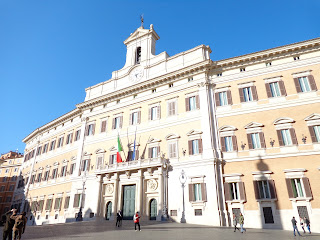 |
| St. Peter's Basilica |
Hey everyone. Well, I wasn't going to narrate these, but I figured what the hell.
On Tuesday, the school organized a trip to Vatican City. At 2:00 we set out on the ten minute walk to the Vatican, and were told of what our tour would consist of. Evidently, there is a stairwell leading to the top of the Dome of the Basilica of St. Peter, so we were to climb to the top of the dome and then exit through the Basilica itself.


The colonnade surrounds the Square of St. Peter, which is topped by statues of Saints and the papal seal.

The Vatican Fountain. If you haven't noticed they are really big about flaunting the water here. I guess if you invented a method for transporting water and you didn't need to fix it for two millennia you would show off too.

Vaticano, the obelisk of the Vatican. Originally used as a spire on the Vatican Circus, it was later used as decoration for the Constantine's Basilica which was the precursor to the renaissance basilica we see today. I apologize for all the obelisk photos, it's just amazing to me how many the Romans stole from the Egyptians.
Also, it was in this Vatican Circus that St. Peter was made a martyr, which is why everything is named after him, let alone that he was the first bishop of Rome.
The Dome of St. Peter's Basilica. This is actually one of the tallest structures in Rome, and I got to go up to the golden observatory on top.
There is a balcony that runs around the "base" of the cupola which was I imagine originally intended for repairs. Now, it's used for the tours. The blurs on the edges are the grating which prevents anything larger than a penny from falling the 50+ feet to the floor.
Then, after a fifteen minute hike up some slanted stairs that hugged the Dome, we saw this:
You could see all of Rome, and beyond. Below there's the Sistine Chapel and the Vatican Gardens
Here I am against the backdrop of Rome,
and here is St. Peter's Square as seen from the Dome.
After a while we descended into the Basilica, and the view from the cupola's balcony did it no justice.
A monument to Pope Pius VIII (front and center)
This is St. Peter's baldachin, the marker for the burial place of St. Peter. As it happens, today it is the entrance to the catacombs where most Popes are buried. To the left is the papal seal of the Barberini family, a member of whom (Pope Urban VIII) commissioned the baldachin.

Finally it was 4:15, the designated meeting time, so we left Il Vaticano and got some gelato nearby. It was a good day, with a great view.
 The Forum of Trajan was one of the Imperial Fora, and the one built by the Emperor Trajan from 106 to 112 AD was the biggest of them all. Thanks to the vast wealth held by Trajan, he was able to level parts of the Quirinal and Capitoline Hills (two of the famous Seven Hills of Rome) and build this complex. As it happens, a good chunk of it has been unearthed, which I saw on the way to the Temple of Hercules Victor in South Rome. The plan of the forum is compliments of the Texas University website.
The Forum of Trajan was one of the Imperial Fora, and the one built by the Emperor Trajan from 106 to 112 AD was the biggest of them all. Thanks to the vast wealth held by Trajan, he was able to level parts of the Quirinal and Capitoline Hills (two of the famous Seven Hills of Rome) and build this complex. As it happens, a good chunk of it has been unearthed, which I saw on the way to the Temple of Hercules Victor in South Rome. The plan of the forum is compliments of the Texas University website.























































